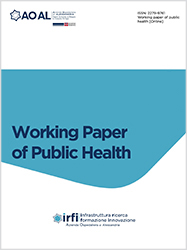Utility of clinical and laboratory data to estimate the probability of bacterial diarrhea diagnosed by stool multiplex Polymerase Chain Reaction assay in a pediatric population

Accepted: 6 October 2023
All claims expressed in this article are solely those of the authors and do not necessarily represent those of their affiliated organizations, or those of the publisher, the editors and the reviewers. Any product that may be evaluated in this article or claim that may be made by its manufacturer is not guaranteed or endorsed by the publisher.
Aims: we estimated the probability of a positive result for the most common bacterial causal agents of diarrhea, such as Campylobacter spp., Salmonella spp., Shigella/Enteroinvasive Escherichia coli, Yersinia enterocolitica or Shiga toxin-producing Escherichia coli by a stool multiplex Polymerase Chain Reaction (PCR) assay in a pediatric population evaluated at the Pediatric and Pediatric Emergency Unit, Children Hospital of the Azienda Ospedaliera SS. Antonio e Biagio e Cesare Arrigo, Alessandria, Italy, during the period April 2022 - July 2023. Methods: we analyzed the clinical data collected by the Pediatrician on the stool sample request form along with complete blood count and C-Reactive Protein (CRP). Results: in our case series, the presence of blood/mucus in stool along with an increased value of CRP are independently associated with a positive result diagnosed by molecular method for bacterial diarrhea caused by the aforementioned pathogens. Conclusions: the results proposed in this paper can be of help in hospital settings without the availability of a stool multiplex PCR assay to estimate the probability of bacterial diarrhea in a pediatric patient.
Jameson JL, Kasper DL, Longo DL, et al. Harrison's Principles of Internal Medicine, 20th edition. New York, USA: McGraw-Hill Education. 2018.
Akhondi H, Simonsen KA. Bacterial Diarrhea. In: StatPearls [Internet]. Treasure Island (FL, USA): StatPearls Publishing. 2023.
Shane AL, Mody RK, Crump JA, et al. 2017 Infectious Diseases Society of America Clinical Practice Guidelines for the Diagnosis and Management of Infectious Diarrhea. Clin Infect Dis. 2017;65:e45-80. DOI: https://doi.org/10.1093/cid/cix669
Sattar SBA., Singh S. Bacterial Gastroenteritis. In: StatPearls [Internet]. Treasure Island (FL, USA): StatPearls Publishing. 2023.
Kaplon J, Théry L, Bidalot M, et al. Diagnostic Accuracy of Four Commercial Triplex Immunochromatographic Tests for Rapid Detection of Rotavirus, Adenovirus, and Norovirus in Human Stool Samples. J Clin Microbiol. 2020;59:e01749-20. DOI: https://doi.org/10.1128/JCM.01749-20
Koletzko S, Osterrieder S. Acute infectious diarrhea in children. Dtsch Arztebl Int. 2009;106:539-47. DOI: https://doi.org/10.3238/arztebl.2009.0539
Carmon D, Rohana H, Azrad M, Peretz A. The Impact of a Positive Biofire® FilmArray® Gastrointestinal Panel Result on Clinical Management and Outcomes. Diagnostics (Basel). 2023;13:1094. DOI: https://doi.org/10.3390/diagnostics13061094
Beal SG, Tremblay EE, Toffel S, et al. A Gastrointestinal PCR Panel Improves Clinical Management and Lowers Health Care Costs. J Clin Microbiol. 2017;56:e01457-17. DOI: https://doi.org/10.1128/JCM.01457-17
Truong J, Cointe A, Le Roux E, et al. Clinical impact of a gastrointestinal PCR panel in children with infectious diarrhoea. Arch Dis Child. 2022;107:601-5. DOI: https://doi.org/10.1136/archdischild-2021-322465
Leli C, Di Matteo L, Gotta F, et al. Evaluation of a multiplex gastrointestinal PCR panel for the aetiological diagnosis of infectious diarrhoea. Infect Dis (Lond). 2020;52:114-20. DOI: https://doi.org/10.1080/23744235.2019.1688861
The European Committee on Antimicrobial Susceptibility Testing (EUCAST). Breakpoint tables for interpretation of MICs and zone diameters. Version 12.0, 2022. Available from: http://www.eucast.org
The European Committee on Antimicrobial Susceptibility Testing (EUCAST). Breakpoint tables for interpretation of MICs and zone diameters. Version 13.0, 2023. Available from: http://www.eucast.org.
The European Committee on Antimicrobial Susceptibility Testing (EUCAST). Breakpoint tables for interpretation of MICs and zone diameters. Version 13.1, 2023. Available from: http://www.eucast.org.
McDonald LC, Gerding DN, Johnson S, et al. Clinical Practice Guidelines for Clostridium difficile Infection in Adults and Children: 2017 Update by the Infectious Diseases Society of America (IDSA) and Society for Healthcare Epidemiology of America (SHEA). Clin Infect Dis. 2018;66:e1-48. DOI: https://doi.org/10.1093/cid/cix1085
Sasaki Y, Ikeda T, Yonemitsu K, et al. Antimicrobial resistance profiles of Campylobacter jejuni and Salmonella spp. isolated from enteritis patients in Japan. J Vet Med Sci. 2023;85:463-70. DOI: https://doi.org/10.1292/jvms.22-0424
García-Fernández A, Dionisi AM, Arena S, et al. Human Campylobacteriosis in Italy: Emergence of Multi-Drug Resistance to Ciprofloxacin, Tetracycline, and Erythromycin. Front Microbiol. 2018;9:1906. DOI: https://doi.org/10.3389/fmicb.2018.01906
The European Committee on Antimicrobial Susceptibility Testing (EUCAST). Expert rules and expected phenotypes. Available from: https://www.eucast.org/expert_rules_and_expected_phenotypes
Pitti M, Garcia-Vozmediano A, Tramuta C, et al. Monitoring of Antimicrobial Resistance of Salmonella Serotypes Isolated from Humans in Northwest Italy, 2012-2021. Pathogens. 2023;12:89. DOI: https://doi.org/10.3390/pathogens12010089
The European Committee on Antimicrobial Susceptibility Testing (EUCAST). Minimum Inhibitory Concentration. Available from: https://mic.eucast.org/
Marcus N, Mor M, Amir L, et al. The quick-read C-reactive protein test for the prediction of bacterial gastroenteritis in the pediatric emergency department. Pediatr Emerg Care. 2007;23:634-7. DOI: https://doi.org/10.1097/PEC.0b013e31814a6a52
Borgnolo G, Barbone F, Guidobaldi G, Olivo G. C-reactive protein in viral and bacterial gastroenteritis in childhood. Acta Paediatr. 1996;85:670-4. DOI: https://doi.org/10.1111/j.1651-2227.1996.tb14121.x
Voth E, Solanky D, Loftus EV Jr, et al. Novel risk factors and outcomes in inflammatory bowel disease patients with Clostridioides difficile infection. Therap Adv Gastroenterol. 2021;14:1756284821997792. DOI: https://doi.org/10.1177/1756284821997792
Copyright (c) 2024 Christian Leli, Valentina Pizzo, Marcella Cerrato, Salvatore Castaldo, Annalisa Roveta, Maria Matilde Ciriello, Enrico Felici, Antonio Maconi, Andrea Rocchetti

This work is licensed under a Creative Commons Attribution-NonCommercial 4.0 International License.
PAGEPress has chosen to apply the Creative Commons Attribution NonCommercial 4.0 International License (CC BY-NC 4.0) to all manuscripts to be published.

 https://doi.org/10.4081/wpph.2023.9842
https://doi.org/10.4081/wpph.2023.9842




